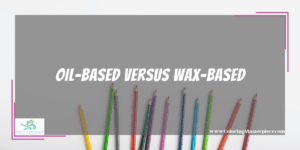As an artist, it is always important to understand the materials with which you work. By knowing what your tools can and can’t do, you are better able to choose the right device for the job. When it comes to colored pencils, an important factor you must consider is whether or not they smear.
Most of us are more familiar with wax-based colored pencils because they are the ones we see in stores. These are the ones we buy for our children’s school supply lists and what we use for everyday projects. That doesn’t mean they are better, nor does the fact they are cheaper mean they are inferior. Colored pencils are available in both oil-based and wax-based because they serve different purposes. Let’s take a look at how they compare to discover which type is best for your needs.
Oil-Based versus Wax-Based

The pigment of colored pencils is held together in one of two ways: oil or wax. The type of binding affects the strength of the pencil’s core. More importantly, the type of binding affects how the color spreads across the page. Oil-based may smear easily, but they offer unparalleled color blending and skillful layering while getting the color deep into the teeth of the paper.
When comparing the two types of colored pencils, the first thing you’ll notice is the price tag. Creating wax-based colored pencils is a relatively easy manufacturing process with a speedy turnaround time. This explains why they are so readily available in such large quantities and at a low price.
Binding the color to the oil is a much more complicated process requiring a longer amount of time to make them and limiting the number of colors available. This, in turn, makes for a higher cost to the manufacturer and, inevitably, is more costly for the consumer. While they are more expensive, the stronger core of the oil-based pencil reduces breakage, making them longer lasting than wax-based. In addition, their strong core allows for sharpening to a finer point, making highly detailed work easier to accomplish.
Another important difference when deciding between oil-based and wax-based colored pencils is the ease of use. Wax-based colored pencils are great for beginners because they are simple to use and won’t smear as you color. Oil-based colored pencils require learning how to use them properly to get the desired effect.
There are a couple of things about wax-based colored pencils that make them a better choice for beginners than the more expensive oil-based colored pencils. The first aspect is related to the range of core softness available in wax-based pencils. Pencils with a harder core are less likely to break and are great for just starting. As you develop your skills you can transition to the softer cores used by professionals.
The second feature that differs between oil-based and wax-based colored pencils is how light or dark the color appears on the paper. Wax-based pencils require more passes across the page to acquire bold and vibrant hues. Oil-based pencils can have thick and chunky strokes, requiring more finesse from the artist to achieve smooth and dynamic colors.
Comparing Techniques
Whichever type you choose to work with, take the time to harness the full creative power colored pencils possess by learning and practicing techniques. Just like learning to play a musical instrument, colored pencils require practice to become a skilled artist.
Defined below are the five different kinds of marks used to apply color on paper when working with colored pencils. These techniques are used alone or in combination to create textures and unique effects.
Five Different Marks to Make
- Stippling – dots placed on the paper close together, far apart, and any distance desired.
- Hatching – a group of parallel lines moving in one direction at variable distances apart.
- Cross-hatching – a set of hatching lines that have another set of lines in the opposite direction and directly on top of the first set of lines.
- Back-and-forth stroke – the most familiar coloring technique involving simple back-and-forth movement without lifting the pencil.
- Scumbling – continuous circular motion upon the paper while moving across the page without lifting the pencil from the page.
Five Keys to Colored Pencil Technique
1. Layer colors so that the top color transforms the one below it
-
- Creates depth on the page so the drawing jumps off the page
- Changes the color’s temperature, value, and intensity
2. Mix colors to create more realistic hues and shades
-
- Example: Layer yellow upon blue to get natural greens
- Colors appear more vibrant and organic
3. Heavy layering of color, creating the look of an oil painting
-
- Allows more fluidity of the colors so they blend on the page visually
- Makes burnishing techniques easier to explore and master
4. Save the detailing for last
-
- Define and refine your drawing after laying down the color
- Develop the details and outlines as you draw
- Planning is okay but pencils give flexibility to the finale
5. Gain mastery and control through patience
-
- Commit time to learning the art
- Explore techniques and experiment with different medium
- Relish in the development of the skill
Different Burnishing Techniques

Burnishing is defined as taking advantage of the type of colored pencil binding to blend and mix colors. It also involves learning how to work the colors into the paper to create an even appearance across the page. While all burnishing techniques will work with both types of colored pencils, their effectiveness will differ between oil-based and wax-based pencils.
- Colorless Blender
- Best suited for wax-based
- The absence of pigment to thin the color
- Creates an even appearance
- White or Cream Colored Pencil
- Suited for both types
- Layered on top of other colors
- Lightens the color’s value
- Solvent
- Best suited for oil-based
- Thins the color
- Creates a smooth appearance
Which Oil-based Brand to Choose
Since wax-based colored pencils are cheaply mass-produced, there is little need to compare in terms of their quality and value. Oil-based colored pencils, however, have variations in how they are produced, thus variances in their quantity and quality. The following is a comparison of the top six oil-based colored pencils available on the market.
Faber-Castell Albrecht Durer
- Available in sets of a single color up to 120 pencils
- Thick, vibrant colors that are easy to control
- Phenomenal blending ability when mixed with water
- Highly ranked visual appeal and exceptional durability
- Packaged in high-quality wood cases or available in low-cost tin cases
- Hexagonal-shaped wood pencil for better grip and control
Faber-Castell Polychromes
- Most recognized brand and leader in sales
- Best suited for vigorous shading and blending
- Core color is accurately depicted on the pencil’s exterior
- Vividly bright colors spring off the page
- Smaller sets limit the color wheel but the full set of 120 makes options endless
- Round wooden exterior for a softer feel and fluid movement
Lyra Rembrandt Polycolor
- Rougher application but smoother blend-ability
- Slightly fewer color choices with sets ranging from 12 to 105 pencils
- Less expensive than some premium pencils but more fragile than other brands
- Thick core but more narrow barrel than comparative oil-based pencils
- Requires heavy application to reach the color quality of the more expensive brands
Caran d’Ache Pablo
- Oil and wax hybrid with a heavier lean towards oil-based
- A strong water-resistant core can sharpen to a fine point
- Highly suited for detailed areas resulting in vivid and intense color
- Smooth intense colors are available in sets of 12 and up to 120 pencils
- Some colors require more layers to achieve depth of color
Spectrum Noir
- A hybrid of wax and oil-based core
- Visually achieve the brightness of waxy pigments and the thick texture of oils
- Available as 5 sets of 12 to obtain the complete spectrum
- Color inconsistencies and overlaps have been found in and among the sets
- Durable for frequent use with adequate blend-ability
Koh-i-noor Polycolor
- Types of binding used create a thicker, dense stroke
- The maximum number of colored pencils in a set is 72
- The core is relatively hard and ideal for fine detail work
- More fragile with frequent breakage compared to other brands
- Colors are consistent but blend-ability ranks low with these pencils
- Great for projects involving shading and transitioning
As with most tools in the world of art, not all are created equal and not all people can use them equally well. Particularly with colored pencils, whether oil-based, wax-based, or somewhere in between, finding the right pencil requires a bit of personal research. And like with all forms of art, it will take time and a significant amount of practice to master the obtainable skills.
Need expert insight into your coloring tools and techniques? Try my free adult coloring eBook and sign up for my email newsletter HERE!
Disclaimer: The information provided by ColoringMasterpiece.com (“The Site”) is for general informational purposes only. All information on the Site is provided in good faith, however, we make no representation or warranty of any kind, express or implied, regarding the accuracy, adequacy, validity, reliability, availability, or completeness of any information on the Site. Under no circumstance shall we have any liability to you for any loss or damage of any kind incurred as a result of the use of the Site or Reliance on any information provided on the Site. Your use of the Site and your reliance on any information on the Site is solely at your own risk. This blog post is for educational purposes only and does not constitute legal advice. Please consult a legal expert to address your specific needs.
Terms and Conditions: https://coloringmasterpiece.com/terms-and-conditions/
